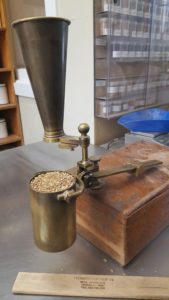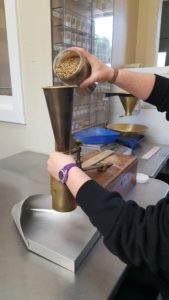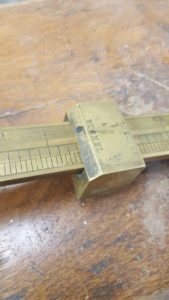
Have you taken a peek at your COA recently? COA stands for certificate of analysis and it tells you interesting chemical and physical properties about the product you are purchasing. If you haven’t checked recently, it’s understandable, many of the terms on the COA may seem to have nothing to do with brewing! One of those terms might be “Bushel weight” – why would a brewer need to know this? Bushel weight is an important physical property that references the bulk density of the grain, but is usually better known to farmers than brewers! To debunk the mysterious crossover of field to glass testing keep reading!

A bushel weight measurement tests the amount of mass that can be fit into a specific volume that was decided by the Department of Agriculture. Unlike the neat and tidy metric measurement system, the U.S. measurement system has unique (this is the polite way for saying bizarre!) standards for measurement. The volume of a bushel is 1.244 cubic feet, typically rounded to 1.25 cubic feet, and the weight of the grain or product in that space is usually measured in pounds.
The bushel weight measurement has changed over the years with the actual physical volume growing to accommodate the more typical crops of today. (Fun Fact: Owen Ruffhead, author of the Statutes at Large, credits King Henry III with regulating the first official bushel weight in the Assize of Bread and Ale).
A bushel is equal to 4 pecks which is equal to 32 quarts (more funky measurements!). Many agricultural commodities are sold by bushel weight, and the Department of Agriculture can also set specific weights for specific commodities. Example: Barley typically uses a sale bushel of 48 lb/bu. In reality, most of our new crop barley is around 53 lb/bu. These bushel weights are pre-determined and may not always correlate with the actual mass that fits into the volume of a bushel for that specific year’s crop harvest (it just got more confusing – but if you are curious you can check out the University of North Carolina’s published U.S. Commercial Bushel sizes).

At Briess, we measure the bushel weight of our whole kernel products. The bushel weight can help brewers determine how much product will fit in their silo. If you buy your ingredients by the bag (or the pouch), the bag will always be the same weight, but could be slightly fuller looking if the bushel weight is low!
Our malt lab has a really unique, neat, older instrument to measure bushel weight which isn’t much different from how farmers measure bushel weight in the field and are still relevant for our applications for testing and measuring today.
A very basic test, grain is funneled from a specific height into a pre-weighed quart jar. The excess grain is scraped off by running what looks like a ruler in a “W” pattern across the mouth of the jar. The grain is measured and scaled up to what an actual bushel would hold (remember earlier how we said a bushel is equal to 32 quarts? We would have to hire bodybuilders to do our bushel weight testing if we didn’t scale down to quarts!). The Briess malt labs then report the bushel weight of your whole kernel grain on the COA!


